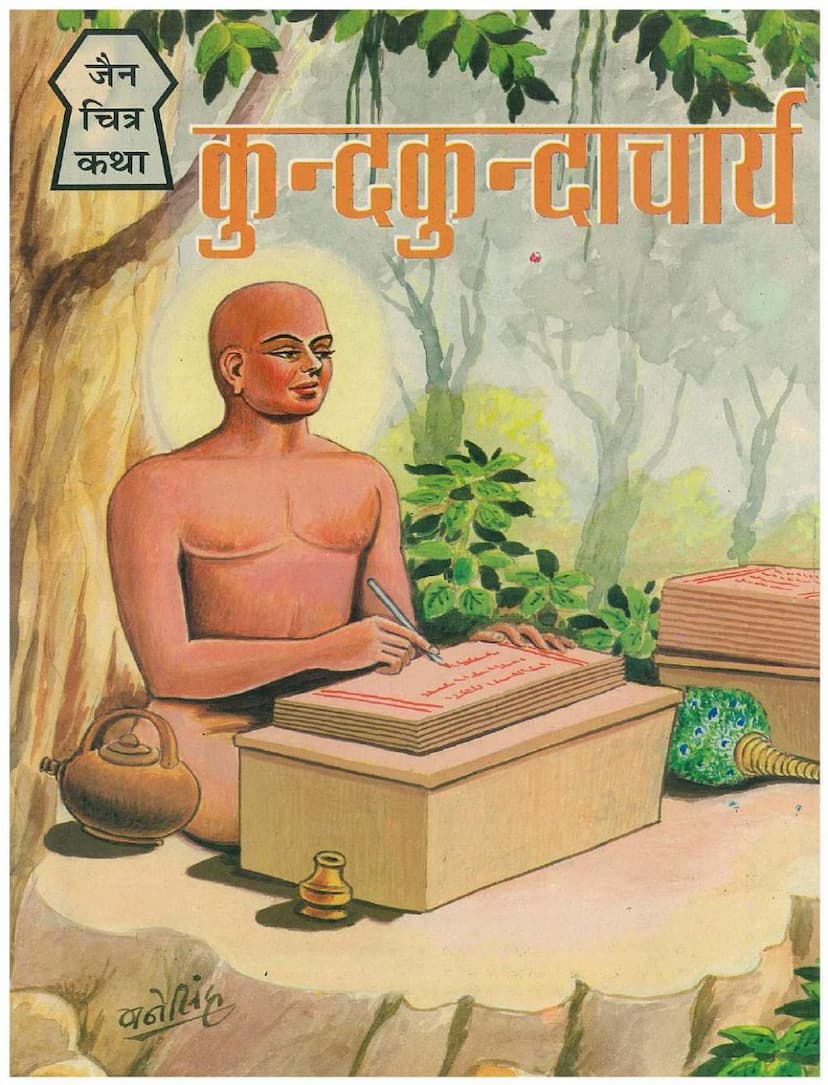Kundkundacharya
Added to library: September 2, 2025

Summary
This Jain book, "Kundkundacharya" by Prabha Patni, published by Acharya Dharmshrut Granthmala, is a biographical account presented in a comic book format aimed at educating children about the prominent Jain Acharya, Kundkundacharya.
The book begins with an editorial highlighting the esteemed position of Acharya Kundkundacharya in the Digambar Jain tradition. It mentions his birth in Kundpur, his original name Padmanandi, and his mastery of Sanskrit and Prakrit languages. The editorial emphasizes his contribution to spiritual introspection and his authorship of 84 Pahud (treatises), with Samaysar being the most significant. It further recounts how divine intervention led him to the presence of Lord Simandhar Swami in Videh Kshetra, where he heard the divine discourse. The editorial also touches upon his role in resolving a dispute between Digambars and Shwetambars by facilitating a miraculous resolution through a stone idol. His severe penance at Ponnurmalai in Tamil Nadu is also mentioned, solidifying his elevated status. The editorial concludes with a salutation to Acharya Kundkundacharya.
The narrative then unfolds as a dialogue between a mother and her son. The son, curious about the initial prayer read at the temple, learns about Mangalacharan (auspicious invocation). He then expresses his desire to understand the significance of Lord Mahavir, Gautam Ganadhar, Kundkundacharya, and Arhat Dharma.
The mother agrees to tell the story of Kundkundacharya, focusing on his life and teachings. The story begins by introducing Karamandu, a merchant in Kurumarainagar in South India, and his wife Shrimati.
The story then shifts to a cowherd named Mathavarin. While grazing, he witnesses a fierce fire in the forest. Despite the danger, his curiosity leads him to investigate the source of the fire. He discovers a hermitage where he finds scriptures left behind by a sage for the welfare of the world. He is unable to read them but realizes their immense value.
Later, a monk visits Karamandu's house and Mathavarin presents the discovered scriptures to him. The monk blesses Mathavarin, foretelling his rebirth as Karamandu's son with a lifespan of one month. The monk also imparts a mantra for courage: "I am in the refuge of Arihant."
The narrative then shows Mathavarin being attacked by a lion in the forest, where he recites the mantra, and miraculously survives. Later, Karamandu's wife gives birth to a beautiful son, whom Karamandu names Kundkund, meaning "like a lotus."
The story then portrays Kundkund's education, where he learns about the six fundamental substances of the universe: Jiva (soul), Pudgal (matter), Dharma (medium of motion), Adharma (medium of rest), Akash (space), and Kala (time).
As Kundkund grows, he expresses a desire to renounce worldly life and become a monk. Despite his youth, his determination impresses his guru, who bestows upon him monastic initiation, recognizing his potential for the betterment of humanity.
The book highlights Kundkundacharya's dedication to penance and his practice of equanimity in the face of life's dualities. He is shown to be writing Samaysar, a treatise on the pure nature of the soul and its relationship with the divine, which aims to guide individuals towards liberation.
The narrative then shifts to a contemporary setting, depicting a conversation between a father and mother about their son's education. The mother emphasizes the importance of imparting spiritual values, while the father expresses concern about the perceived irrelevance of such teachings in the modern world. They discuss the contemporary violence and the peaceful teachings of great figures like Mahavir, Nanak, and Gandhi.
The story returns to Kundkundacharya, detailing his extensive writings, including Samaysar, Niyamsar, Pravachansar, Panchastikaya, and Ashtapahud. It emphasizes his enduring legacy, with his teachings still revered after two millennia. The core message he left behind is that "character is the best in the world and must be protected at all costs."
The book concludes with a "Profile" of Shri Dhannalalji Patni, who was a devout Jain and a supporter of the publication. It details his life, his spiritual practices, his devotion to his gurus, and his peaceful passing. It also mentions his family, including his wife, daughters (one of whom is Aryika 105 Syadvadmati Mataji, a significant contributor to Jain literature), and grandchildren, all of whom are noted for their religious upbringing and contributions to Jainism. The publication is dedicated to his memory and highlights his role as a patron.